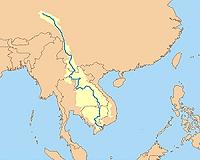| . |  |
. |
Brasilia, Brazil (UPI) Apr 29, 2011 Brazilian mining giant Vale will pay $1.4 billion for a stake in the consortium building the controversial Belo Monte dam in the Amazon. Noting that it is already a large investor in hydroelectric plants, including nine plants in Brazil and three in Indonesia, Vale said Thursday that the acquisition of a stake in Belo Monte will increase to 45 percent the portion of the company's global energy consumption met by its own power generation. The proposed 11,233 megawatt Belo Monte project on the Xingu River would be the world's third largest hydroelectric dam after China's Three Gorges and Itaipu, which Brazil jointly operates with Paraguay. It is slated for completion in 2015, at an estimated cost of $17 billion. But Belo Monte is opposed by environmentalists, Indian rights groups, social rights activists and others, who say the dam would disrupt the Amazon ecosystem and displace as many as 50,000 people from indigenous Amazonian tribes. Filmmaker James Cameron has compared Belo Monte's construction on a major tributary of the Amazon River to the environmental destruction depicted in his film "Avatar." The dam's massive cement wall would flood 195 square miles of jungle. Brazilian Defense Minister Nelson Jobim earlier this month said the government wouldn't honor an Organization of American States' request that it stop work on the controversial dam. Jobim said Brazil sets aside close to 11 percent of its national territory for indigenous communities, while noting that efforts to preserve their way of life shouldn't force 20 million people in the Amazon region into underdevelopment. Infrastructure work on the dam officially began a month ago, starting with the clearing of 588 acres of rainforest and the construction of access roads. Belo Monte will use a run-of-river, or streaming hydro system, in which the river continues to run rather than being held back by a large dam. But its power generation is expected to average only 40 percent of its 11,233 megawatt capacity because of huge fluctuations in the Xingu's rate of flow, from a high of 30,000 cubic meters a second during the rainy season, to around 1,000 cubic meters a second during the dry season. That means the country will have to rely on its coal, oil and natural gas-fired thermal power stations to ensure electricity supplies, leading to a "dirtier" energy mix and driving up the cost of electricity.
Share This Article With Planet Earth
Related Links Water News - Science, Technology and Politics
 US welcomes delay in controversial Mekong dam
US welcomes delay in controversial Mekong damWashington (AFP) April 26, 2011 The United States on Tuesday welcomed a delay in construction of a controversial dam on the Mekong River, voicing hope that Southeast Asian nations would work to ensure it is environmentally sound. Cash-strapped Laos wants to go ahead with the $3.8 billion Xayaburi dam which would generate hydropower for export, but a meeting last week with officials from Cambodia, Thailand and Vietnam put o ... read more |
|
| The content herein, unless otherwise known to be public domain, are Copyright 1995-2010 - SpaceDaily. AFP and UPI Wire Stories are copyright Agence France-Presse and United Press International. ESA Portal Reports are copyright European Space Agency. All NASA sourced material is public domain. Additional copyrights may apply in whole or part to other bona fide parties. Advertising does not imply endorsement,agreement or approval of any opinions, statements or information provided by SpaceDaily on any Web page published or hosted by SpaceDaily. Privacy Statement |